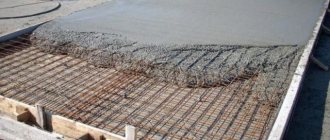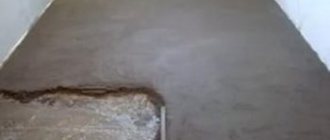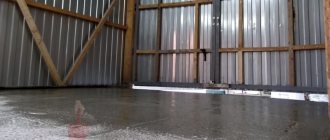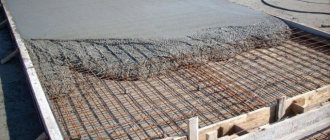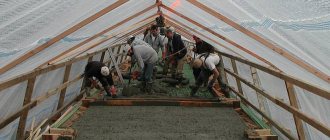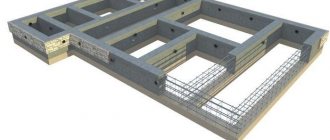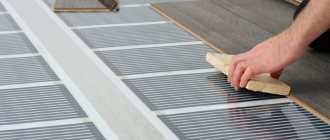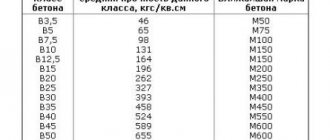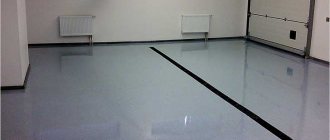Today, the use of concrete screed has gained wide popularity among the population. But before you start working with it, there are a few things you should know. Concrete is a building material that is created artificially and is characterized by durability. To create it, you need to mix all the ingredients in the required proportions into a mixture. After the solution is poured, it compacts and hardens. This turns it into a durable stone.
Many experts argue that to improve performance characteristics, concrete needs to be watered. But a logical question arises: in what cases is this necessary? First you need to understand the solidification process. This will give you an idea of why builders use water when working on a cement structure.
Existing types of foundation
You can calculate the amount of material for the foundation yourself or use the services of a specialized design company. The entire process of laying the foundation, as well as its subsequent maintenance, must occur strictly in accordance with the requirements of the project, adhering to the proportions. There are several types of fundamental foundations, and they are divided according to the material used, as well as the installation method:
Rubble concrete foundation
- Rubble - its installation is distinguished by bandaging the seams with cement mortar;
- Rubble-concrete – installation is carried out by pouring concrete into wooden formwork;
- Reinforced concrete, concrete - such a structure can be either monolithic or prefabricated and can consist of several elements.
But it doesn’t matter what type of foundation is under the house, the main thing is that the care of the concrete after pouring must be of high quality. This is done to obtain a sole of increased reliability and strength, and to ensure that the erected building lasts as long as possible.
Before starting any construction, you need to familiarize yourself with all types of foundation structures:
- Tape - laid around the entire perimeter on the inside and outside of the wall.
- Solid - has the form of a monolithic slab of reinforced concrete and is intended for installation in places where the soil is too mobile.
- Columnar - placed either under free-standing supports or under a wall.
- Pile - the structure of the structure is installed on piles immersed in the ground and filled with concrete.
Each designed house has its own foundation, the type of which depends on the mass of the future building, the characteristics of the soil, the quality of the concrete mixture and the material that will be used.
Mixture composition
When we hear or say “concrete,” we rarely think about what this material is. And, of course, we don’t think at all about why all the instructions for caring for freshly poured concrete structures state that it is necessary to water the concrete. If we try to combine all the definitions found in the specialized literature into one, we will get a definition that explains that concrete is an artificial stone material that is formed by a rationally selected, thoroughly mixed and compacted, hardened mixture.
Concrete floor diagram.
The concrete mixture includes: binder (cement), coarse and fine aggregates (gravel or crushed stone and sand, respectively), water and special additives (if needed). The density of concrete in the hardened state should be 2200-2500 kg/m³.
Water and binder are the active components of the concrete mixture, which envelop the grains of the passive element of the concrete mixture - the aggregate - with a thin film. Over time, the water that softens the binder evaporates, the binder hardens and binds the enveloping aggregate grains, turning the mixture into a durable monolithic artificial stone - concrete.
Aggregates in a concrete mixture occupy 80-85% of the volume of concrete. It is clear that the properties of the aggregate directly determine what physical and mechanical properties concrete will be in the future. It is easy to calculate that for the two active components of the concrete mixture - cement and water - 15-20% remains in the volume of the concrete mixture. With the generally accepted ratio of cement to water 2:1, cement occupies 10-13%, and water, respectively, 5-7% of the volume. For most brands of concrete, this figure is 190-200 liters per 1 m³ of concrete mixture.
How to work with concrete correctly
Vibration compaction of concrete
The most important and troublesome moment is the moment of pouring the fundamental foundation of the building. Those people who are going to build a house with their own hands need to learn that any work with concrete consists of three components:
- The stage of preparing a concrete mixture.
- Pouring concrete mixture.
- Maintenance of fresh concrete.
These stages have a direct connection with each other. If you make the slightest, even insignificant mistake, you can forget about the strength and quality of the foundation under the structure. Therefore, each of the works included in the overall process of constructing a foundation must be performed by a specialist with certain skills, knowledge, and in compliance with the rules. In addition, you need to approach each stage with special responsibility. Only then will you get a reliable foundation that will not be subject to destruction or cracking during use.
Concrete watering frequency
Periodic moistening during the day and night allows you to maintain a sufficient level of moisture in the concrete.
The frequency of the procedure depends on weather conditions and the characteristics of the cement:
- When the air temperature exceeds +15°C, concrete is watered from the second day after pouring. You need to moisturize for 7-15 days.
- When the average temperature reaches +10°C, water for up to 1.5 weeks.
- In the first days, water 4-5 times a day, and after 5 days - several times, if it is not hot outside.
- In hot and windy weather, the intervals between watering should be at least 1.5-2 hours, and in cloudy periods - at intervals of 3 hours.
- Slag or pozzolanic Portland cement needs to be moistened 5-7 times a day for 2-3 weeks.
- Aluminous cement requires moisture for 7 days.
Less water evaporates from the concrete that is in the formwork. After its removal, the demoulded surface of the foundation also needs watering.
Proper maintenance of concrete base
Freshly poured concrete
Freshly laid concrete needs special attention. This consists in creating a condition that will promote hydration of the solution. Simply - transforming it from a liquid or plastic mixture into a hardened stone made of cement. As a result of this process, the concrete will gain strength and strength. For this to happen, you need to wait almost a month. Some scientists have even proven that it takes much more time - about several years - for hardening to reach its peak, but the air temperature in the room should be 20-25 degrees, and a certain humidity is also required.
The pouring time directly affects the way it is cared for. Therefore, caring for concrete in the winter is the exact opposite of the rules for caring for the base in the summer. This must be remembered and applied, since the seasons of the year leave their mark on the quality and characteristics of the foundation.
Why wet concrete?
As cement dries, it decreases in volume and shrinks. When the concrete mass is thick, it dries unevenly. Then the inner layer retains moisture, maintaining the same volume, and the surface dries out, decreasing in volume.
As a result, the spaces between these areas suffer from surface tension; the concrete crust tends to compress and decrease, but this is not enough to cover a larger deep layer. This leads to cracks.
To prevent cracking of the solution, it must be looked after - ensure uniform distribution of temperature and humidity in all its areas. With a decrease in the number of such differences, the quality of the foundation increases.
During the process of binding sand and crushed stone, a sufficient volume of water is required for the cement to react with the liquid. When the surface dries unevenly and there is not enough water, some areas remain unused until the end. The loss of water must be replenished by moistening the concrete.
Summer way to care for concrete
It is not recommended to deliver concrete mixture in the heat, so it is better to do it either early in the morning or in the evening, after the sun has set. The poured solution on a sunny day needs to be provided with additional protection. It is covered with roofing felt, slate sheets or other material suitable for this purpose.
Caring for concrete during rain is to prevent the solution from being washed away and holes from forming on the poured surface.
Clearly organized work throughout the concreting process is very important. When ordering ready-made concrete mortar from a construction company, make sure that its delivery to the construction site does not exceed 1 hour. Having received the concrete, it is necessary to pour it immediately to prevent it from quickly hardening.
Foundation care
Self-mixing should be carried out in accordance with SNP standards, and quickly poured into the place prepared for the base. In summer, cement mixtures dry much faster, so you can’t hesitate for a second. If you do not adhere to the rules, the concrete will be irrevocably damaged.
Caring for concrete in the summer requires constant moistening and compliance with all necessary measures to prevent the evaporation of water from the newly poured base. Such procedures are necessary because, in addition to high temperatures, there is also heat that the solution releases during hydration. Thorough watering is needed during the first three days after installing the foundation.
How often should you pour water on the foundation? This question is asked by many people who have virtually no knowledge of the rules for caring for concrete. If the air warms up to a temperature of more than 15 degrees above zero, then the concrete is watered once every 10-12 hours, and if the weather is windy, then every 2 or 3 hours.
In general, caring for a poured base is nothing more than maintaining normal humidity and temperature conditions during the hardening process of concrete.
How many days should concrete be watered after pouring?
Many novice builders, after pouring concrete, naively believe that the work is finished and all that remains is to wait for the foundation to completely harden, but this is not so.
Any experienced worker knows that concrete after pouring needs to be watered with water for greater strength. Moreover, the duration and frequency of watering depends on the ambient temperature.
Why do you need to water concrete after pouring?
In general, the technology requires 28 full days for the foundation to completely harden, although walls begin to be erected after 2-3 weeks. However, usually, under the influence of temperature, the top layer hardens much faster than the middle and especially the bottom.
When this happens, microcracks occur, greatly reducing the service life of the structure. This becomes most noticeable during the cold season, since water can accumulate in them, and after freezing, it breaks the concrete. Over time, small cracks turn into larger ones.
How often should concrete be watered after pouring?
As a last resort, the procedure is performed 10 hours after the end of concreting, but only if the weather permits. In very hot or windy weather, the first watering should be done after 2-3 hours. You need to water the foundation day and night, constantly keeping the top layer moist.
If the weather is very hot or windy, watering should be done every 1.5-2 hours, increasing the interval in the morning, evening and night. The weather can be considered hot when the temperature in the sun is more than 15 degrees.
At an air temperature of 15 degrees, you need to water every 3-4 hours during the day and 1-2 times at night. If the weather is 5 degrees or less, then there is no need to water the concrete. In theory, you can make a schedule from these 3 points and water according to it, but it is much more reliable to touch the concrete to understand whether it is wet enough or not.
How to prevent chipping and cracking in the foundation
How to care for concrete if it has just been laid? Remember that water must be sprayed with a spray bottle. Do not water concrete with a strong stream, as it may cause potholes.
It is necessary to carefully water the edges and connecting places. These parts of the structure are the first to dry out, and therefore are most susceptible to cracking and chipping.
According to GOST, when constructing highways or other open surfaces, in order to retain moisture in them, a film-forming material (bitumen emulsion, “Ethinol” varnish coating) is used. Since these structures get rid of moisture not only naturally, but also through its absorption by the base, their moistening should be more thorough and occur more often.
Concrete does not need watering if the temperature is less than 5 degrees Celsius.
Any construction project is a rather serious and responsible undertaking, so here, as in any other organization, there is appropriate reporting documentation. For example, there must be a concrete maintenance log, which serves as a control document recording the quality and condition of the installation. It immediately shows when and how the concreting work was carried out.
The influence of chemical compounds on the quality of concrete
There is a lot of water in concrete - from 155 liters per 1 m3, depending on the fraction of crushed stone, sand, and the expected brand of stone. The liquid interacts with every grain of sand and dust of cement, so its quality affects the entire volume of the future structure. How do chemical compounds in water affect the properties of concrete if the established GOST standards are neglected?
- Sugars and phenols delay the hardening of concrete and greatly impair its quality. The normalized content of these substances is 10 ml/liter;
- Petroleum products form a waterproof film on binder particles;
- Surfactants (soap residue) also coat the components. Unlike improvers, they only slow down hardening;
- Soluble salts of sulfate ions and chlorine ions crystallize in the pores of concrete, leading to corrosion of stone and reinforcement. For this reason, using sea water is strictly prohibited.
Sewage, swamp and river waters can be used for mixing concrete and cement, but only after cleaning and inspection by the sanitary-epidemiological station.
Watering errors
You cannot water with a high-pressure jet, otherwise the foundation will be deformed. Some people use water from swamps and ponds that are contaminated with industrial waste for irrigation.
The ingress of impurities from a reservoir onto the surface of the concrete mixture will interfere with the normal adhesion of microparticles and slow down the hardening of concrete.
It is not recommended to moisten the solution if construction work occurs during the cold season. As a result of waterlogging, the opposite effect will occur and the strength of cement will decrease.
Share this article with your friends on social media. networks!
Watering instructions
It is advisable to irrigate by spraying a stream of water through the nozzle, paying attention to the following features:
- In areas of nodes and edges, moisture evaporates faster, which can cause chips and cracks, so they need to be watered thoroughly.
- When the surface area is large, moisture can be prevented from evaporating by keeping it under a film.
- The water should be sprayed evenly.
- Moisture loss occurs not only through the top layer of the solution. The base also requires moisture.
- If the air temperature drops to +5°C, there is no need to water.
